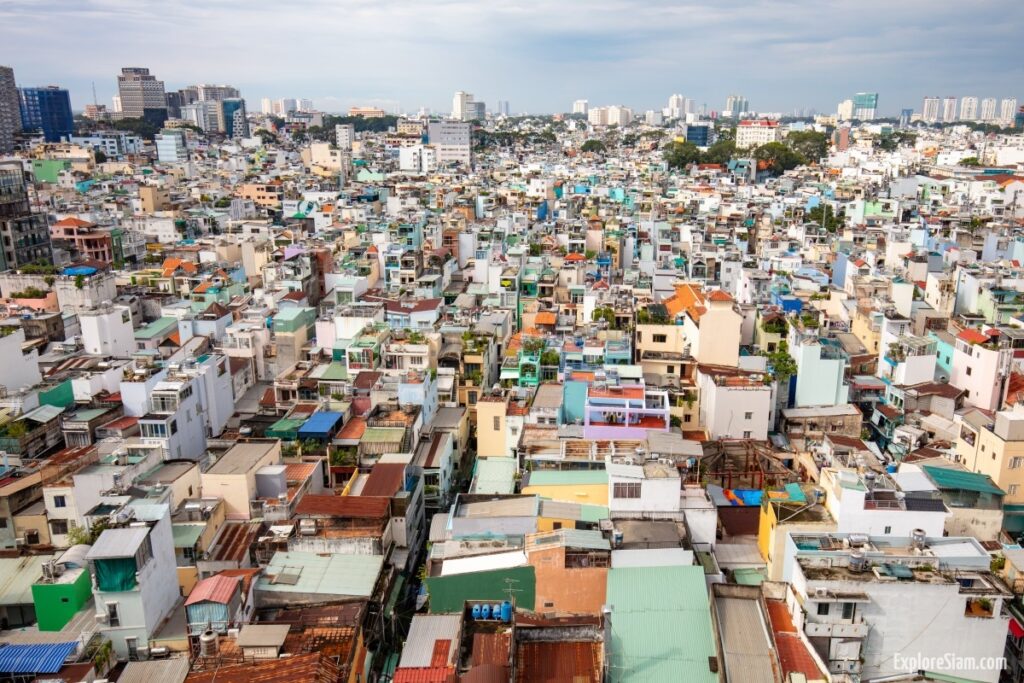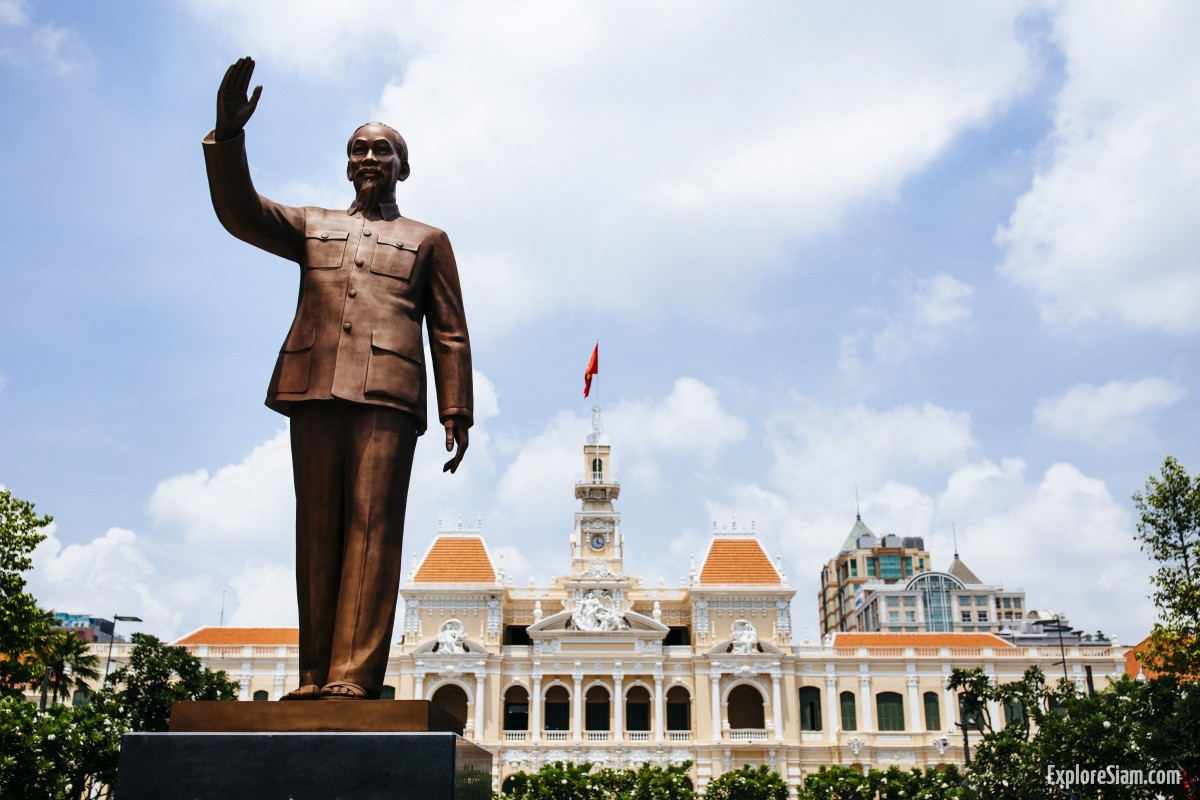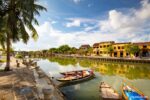Ho Chi Minh City, known to many as Saigon, is a city of dynamic contrasts, where ancient traditions intertwine with rapid modernization. As Vietnam’s largest metropolis, it stands as a symbol of the country’s resilient spirit, blending a storied past with a vibrant present. With its bustling streets, towering skyscrapers, and rich cultural tapestry, Ho Chi Minh City is a gateway to the essence of Vietnam, offering a kaleidoscope of experiences that captivates every visitor.
A Historical Odyssey
Ho Chi Minh City’s history is a complex tapestry woven from its days as a small Khmer trading post to its rise as Saigon under French colonial rule. The city’s strategic location made it a crucial hub in Southeast Asia, drawing influences from across the region and beyond. The French colonial period left an indelible mark on the city, evident in its architecture, cuisine, and cultural institutions. The tree-lined boulevards, grand buildings, and stately villas of District 3 are relics of this era, offering a glimpse into the city’s colonial past.
The Reunification Palace, formerly the Presidential Palace, stands as a monument to the Vietnam War and the country’s subsequent reunification. It was here that the North Vietnamese tanks famously crashed through the gates on April 30, 1975, marking the end of the war. Today, the palace is preserved as a museum, where visitors can explore the historic chambers and view the original tanks that remain on the grounds.
The War Remnants Museum provides a sobering perspective on the war, with exhibits that focus on the impact of the conflict on the Vietnamese people. The museum’s photographic displays, personal accounts, and wartime relics offer a powerful reminder of the human cost of war and the resilience of the Vietnamese people.
The Rise of a Modern Metropolis
Ho Chi Minh City’s modern incarnation is a bustling urban center where tradition and innovation coexist. The cityscape is a reflection of Vietnam’s rapid economic growth, with new developments springing up alongside historic neighborhoods. District 1, the city’s commercial core, is a testament to this growth, with its mix of high-rise buildings, luxury hotels, and upscale shopping centers. The iconic Bitexco Financial Tower, with its lotus-inspired design, symbolizes the city’s aspirations and offers panoramic views of the sprawling urban landscape from its Sky Deck.
Yet, amidst this rapid development, the city has retained its cultural heart. The streets are alive with the sights, sounds, and smells of daily life. Motorbikes weave through the chaotic traffic, vendors sell everything from street food to souvenirs, and the aroma of freshly brewed Vietnamese coffee fills the air. Ben Thanh Market, one of the city’s oldest and most famous markets, is a microcosm of the city’s vibrant street life. Here, you can find a dizzying array of goods, from fresh produce to handcrafted items, all while engaging in the time-honored tradition of haggling.

A Cultural Mosaic
Ho Chi Minh City is a melting pot of cultures, where influences from Vietnam’s diverse ethnic groups, colonial past, and global connections converge. The city’s temples and pagodas offer a window into its spiritual life, with each site reflecting the beliefs and practices of its community. The Jade Emperor Pagoda, with its intricate carvings and statues, is one of the city’s most revered places of worship, attracting both locals and tourists alike. The Thien Hau Temple in Cholon, the city’s Chinatown, is dedicated to the sea goddess Mazu and is a focal point for the city’s Chinese-Vietnamese community.
Cholon itself is a fascinating area to explore, with its maze of narrow alleys, bustling markets, and historic buildings. This district, home to one of the largest Chinese communities in Vietnam, is a blend of old and new, where traditional Chinese medicine shops stand alongside modern cafes and boutiques. The Binh Tay Market, at the heart of Cholon, offers a sensory overload of sights, sounds, and smells, from exotic fruits to freshly cooked street food.
Art and culture thrive in Ho Chi Minh City, with a burgeoning contemporary art scene that reflects the city’s dynamic spirit. The Ho Chi Minh City Museum of Fine Arts, housed in a French colonial-era mansion, showcases a diverse collection of Vietnamese art, from traditional lacquer paintings to modern installations. The city’s many galleries and art spaces, such as the Factory Contemporary Arts Centre, provide a platform for emerging artists to showcase their work, contributing to the city’s reputation as a cultural hub.
Culinary Adventures
No visit to Ho Chi Minh City is complete without indulging in its culinary delights. The city’s food scene is a reflection of its cultural diversity, with influences from across Vietnam and beyond. From high-end restaurants to street food stalls, the flavors of Ho Chi Minh City are as varied as its people. The city is a paradise for food lovers, offering everything from pho, the quintessential Vietnamese noodle soup, to banh mi, a French-inspired sandwich filled with an array of meats, vegetables, and herbs.
Street food is an integral part of life in Ho Chi Minh City, with vendors setting up shop on every corner, serving up delicious and affordable meals. A stroll through the city’s streets will lead you to stalls selling everything from grilled meats and fresh spring rolls to sweet treats like che, a traditional Vietnamese dessert made with beans, coconut milk, and fruit. Each district has its culinary specialties, making it worth exploring the city’s various neighborhoods to fully experience the diversity of its cuisine.
For a more immersive experience, consider joining a food tour or taking a cooking class. These activities offer a deeper understanding of Vietnamese food culture, from sourcing fresh ingredients at a local market to learning the techniques behind classic dishes. Whether you’re a seasoned foodie or a curious traveler, Ho Chi Minh City’s culinary landscape promises an unforgettable journey for your taste buds.
Exploring the Districts
Ho Chi Minh City is divided into 24 districts, each with its own unique character and attractions. District 1 is the city’s bustling commercial center, home to many of its key landmarks, including the Notre-Dame Cathedral Basilica of Saigon, the Saigon Central Post Office, and the Opera House. These architectural gems are remnants of the city’s colonial past, offering a stark contrast to the modern skyscrapers that dominate the skyline.
District 3, known for its leafy boulevards and historic villas, offers a more relaxed atmosphere. This district is home to many of the city’s cultural institutions, including the War Remnants Museum and the Jade Emperor Pagoda. The area is also a popular spot for those looking to experience the city’s cafe culture, with numerous cafes offering a blend of traditional Vietnamese coffee and modern espresso drinks.
District 5, or Cholon, is the city’s Chinatown and one of its most vibrant neighborhoods. This area is a maze of bustling markets, traditional Chinese medicine shops, and historic temples. It’s a place where the old ways of life are still very much alive, offering a fascinating glimpse into the city’s Chinese-Vietnamese heritage.
Venture further afield to District 7, and you’ll find Phu My Hung, a modern urban area that feels worlds away from the chaotic streets of the city center. This district is characterized by its wide boulevards, manicured parks, and upscale residential areas. It’s a popular spot for expatriates and affluent locals, offering a more tranquil and organized environment.
District 2, once a sleepy suburban area, has rapidly transformed into one of the city’s most sought-after districts. This area is now home to a mix of luxury apartments, trendy cafes, and boutique shops, attracting both locals and expatriates. The district’s riverside location also offers some of the best views of the city skyline, making it a popular spot for dining and relaxation.

Day Trips and Excursions
While Ho Chi Minh City offers a wealth of attractions within its borders, it also serves as a gateway to some of southern Vietnam’s most fascinating destinations. The Cu Chi Tunnels, located just outside the city, provide a glimpse into the ingenuity and resilience of the Viet Cong during the Vietnam War. This extensive network of underground tunnels was used as a base of operations during the conflict and has been preserved as a historical site. Visitors can explore the tunnels, learn about the daily life of the soldiers who lived there, and even try their hand at shooting an AK-47 at the nearby firing range.
For those seeking a more tranquil experience, the Mekong Delta offers a serene escape from the hustle and bustle of the city. This vast network of rivers, swamps, and islands is known for its lush landscapes, floating markets, and traditional villages. A boat tour of the delta provides an opportunity to see a different side of Vietnam, where life moves at a slower pace, and the natural beauty of the region takes center stage. The delta is also home to a rich variety of wildlife, including rare birds and fish, making it a popular destination for nature lovers.
Vung Tau, a coastal city located just a short drive from Ho Chi Minh City, is another popular day trip destination. Known for its sandy beaches, seafood restaurants, and colonial-era architecture, Vung Tau offers a refreshing break from the urban heat. The city is also home to the Giant Jesus, a towering statue of Christ that offers panoramic views of the coastline from its perch atop Small Mountain.
The Nightlife Scene
As the sun sets, Ho Chi Minh City transforms into a vibrant playground where the nightlife comes alive. The city’s bars, clubs, and live music venues cater to a diverse crowd, offering everything from rooftop cocktails to underground beats. District 1 is the epicenter of the nightlife scene, with a wide range of options to suit every taste.
Rooftop bars, like Chill Skybar and Rex Hotel Rooftop Garden, offer stunning views of the city skyline and are perfect for enjoying a sunset cocktail. For those looking to dance the night away, clubs like Lush and Apocalypse Now are popular spots where the music plays until the early hours. Live music lovers will find plenty of venues offering everything from jazz and blues to rock and indie.
For a more relaxed evening, the city’s cafes and tea houses offer a quieter setting to unwind. Vietnamese coffee culture is deeply ingrained in daily life, and there’s no better way to experience it than by sipping a strong, sweetened cup of ca phe sua da (iced coffee with condensed milk) in a local cafe. Alternatively, you can catch a traditional water puppet show at the Golden Dragon Water Puppet Theatre, where this ancient art form is brought to life through performances that depict scenes from Vietnamese folklore and rural life.
The Future of Ho Chi Minh City
Ho Chi Minh City is a city in constant flux, where the past and future are in a perpetual dance. Its rapid growth and modernization are a testament to Vietnam’s resilience and determination to forge a new path, yet the city remains deeply connected to its roots. The blend of history, culture, and modernity makes Ho Chi Minh City a unique destination that offers something for every traveler.
As the city continues to evolve, it remains a place where the old and the new coexist harmoniously, creating a dynamic environment that is both exhilarating and enriching. Whether you’re exploring its historical landmarks, indulging in its culinary delights, or simply soaking in the energy of its streets, Ho Chi Minh City promises an unforgettable journey that will leave you with a deeper understanding of Vietnam’s past, present, and future.
Website: hochiminhcity.gov.vn





